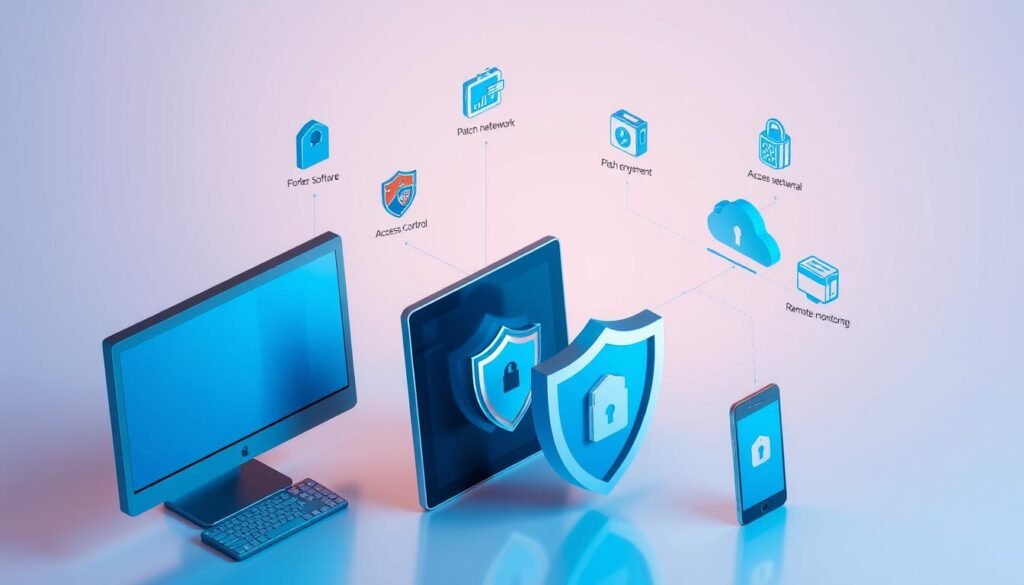In today’s digital world, cyber threats are getting smarter and more dangerous. They pose big risks to your company’s important data and assets. As we head into 2025, businesses face many security challenges. These include ransomware, phishing, zero-day attacks, and insider threats.
To keep your business safe, you need strong cybersecurity solutions. This means using top-notch endpoint security to spot, stop, and handle new threats. In this article, we’ll talk about why business protection is key. We’ll also share the best ways to protect your digital assets.
Key Takeaways
- Understanding the evolving threat landscape and its impact on businesses
- The importance of implementing robust cybersecurity solutions
- Effective strategies for protecting business assets and data
- Best practices for deploying comprehensive endpoint security measures
- Key considerations for selecting the right cybersecurity solutions
Understanding Endpoint Security Fundamentals
Businesses in Egypt are moving to hybrid work models. This makes understanding endpoint security key. With BYOD policies, more devices are connected, making security harder.
What Constitutes an Endpoint in Modern Business
Any device that connects to a network is an endpoint. This includes laptops, smartphones, tablets, and IoT devices. In modern business, endpoints are more diverse and numerous than ever, making comprehensive security a challenge.
The Evolving Threat Landscape in Egypt
The threat landscape in Egypt is always changing. Cyberattacks are getting more complex. Cybercriminals are exploiting vulnerabilities in endpoints to gain unauthorized access to sensitive data. Businesses must stay vigilant and adapt their security measures.
Why Traditional Security Measures Are No Longer Sufficient
Traditional security like antivirus software and firewalls are not enough. Advanced threats require advanced security solutions, including endpoint detection and response (EDR) and security awareness training for employees.
To protect your business, you need to know endpoint security basics. Implementing strong measures is crucial to safeguard your endpoints.
Assessing Your Business’s Endpoint Security Needs

Your business’s endpoint security needs are key to a strong cybersecurity plan. To keep your digital assets safe, you must first know your current endpoint security status.
Conducting a Thorough Security Audit
A detailed security audit is vital to find weak spots in your endpoint security. You need to check your current security tools, like antivirus software and firewalls. Make sure they are updated and working right.
Identifying Vulnerable Points in Your Network
Finding weak points in your network is crucial for better endpoint security. Look at all devices connected to your network, like laptops and servers. This helps spot any security gaps.
Prioritizing Security Investments Based on Risk Assessment
After finding vulnerabilities, it’s key to focus on the most critical areas. A thorough risk assessment helps decide where to put your security money. This way, you can tackle the biggest threats first.
| Risk Level | Threat Description | Recommended Action |
|---|---|---|
| High | Potential data breach or significant financial loss | Immediate mitigation and enhanced security measures |
| Medium | Possible disruption of service or moderate financial loss | Implementation of additional security controls and monitoring |
| Low | Minimal impact or low likelihood of occurrence | Regular review and update of security policies |
Comprehensive Endpoint Security for Your Business: Essential Components

To keep your business safe, you need to know about key parts of endpoint security. A strong endpoint security plan has many layers to protect your digital stuff.
Antivirus and Anti-malware Protection
Antivirus and anti-malware protection are your first defense against threats. They find, stop, and remove malware from your devices. Make sure your antivirus is always up to date to fight new threats.
Endpoint Detection and Response (EDR) Solutions
Endpoint Detection and Response (EDR) solutions do more than antivirus. They watch what your devices do and find advanced threats. EDR tools give you quick info on security issues, so you can act fast.
Firewall and Network Security Controls
Strong firewall and network security controls are key for managing network traffic. They block unwanted access to your network, lowering the chance of data breaches.
Data Encryption and Access Management
Data encryption makes sure data is safe even if it’s caught in the middle. With strict access management, only the right people can see your data.
Mobile Device Security Considerations
With more people working on the go, mobile device security is crucial. Use mobile device management (MDM) to keep mobile devices safe and in check when they access your data.
| Security Component | Description | Benefits |
|---|---|---|
| Antivirus and Anti-malware | Software that detects and removes malware | Protects against known threats |
| EDR Solutions | Monitors endpoint activities for advanced threats | Real-time threat detection and response |
| Firewall and Network Security | Controls network traffic | Blocks unauthorized network access |
Implementing Endpoint Security Solutions
Protecting your business from cyber threats is key. A good plan keeps your data and IT safe from attacks.
Selecting the Right Security Tools for Your Business Size
Choosing the right security tools is crucial. Think about your business size, industry, and needs. Small businesses need simple solutions, while big ones need more.
Deployment Strategies and Best Practices
Deploying security tools right is important. Do risk assessments, set up tools for your needs, and keep them updated. Experts say, “a good endpoint security setup can lower cyber attack risks.”
Integration with Existing IT Infrastructure
It’s important for your security tools to fit with your IT. Make sure they work well with your systems. This boosts security without slowing down your work.
By picking the right tools, deploying them well, and fitting them into your IT, you’ll improve your security a lot.
Managing and Monitoring Your Endpoint Security
Managing endpoint security is a constant task that needs ongoing attention. As threats change, having strong strategies is key to protect your business.
Establishing Regular Security Maintenance Protocols
Regular security checks are vital to find and fix vulnerabilities early. This includes routine software updates, patch management, and system checks. A set maintenance schedule keeps your security up-to-date and working well.
Monitoring Tools and Incident Response Plans
Good monitoring tools are essential for catching security breaches fast. They help you act quickly to limit damage. An incident response plan guides you on how to handle a breach, ensuring a swift and effective response.
Employee Training and Security Awareness Programs
Employees are your first defense against cyber threats. Training programs teach them about security best practices and staying alert. Regular security awareness programs keep your team focused on security.
Security experts say, “A well-trained employee is crucial for strong endpoint security.” Investing in training is essential for your business’s safety.
Conclusion
The threat landscape in Egypt is changing fast. Traditional security methods are not enough to keep your business safe. In 2025, we need advanced security that uses EDR, XDR, and EPP together in Zero Trust systems.
It’s important to focus on complete security solutions for your business. You need to keep learning and stay current with new endpoint security trends. With strong endpoint security, you can fight off new threats and keep your customers’ trust.
Having a solid endpoint security plan is key for your business. You should check your security needs, pick the right tools, and watch your endpoint security closely. By being proactive with endpoint security, you can keep your business running smoothly and protect your important assets.

